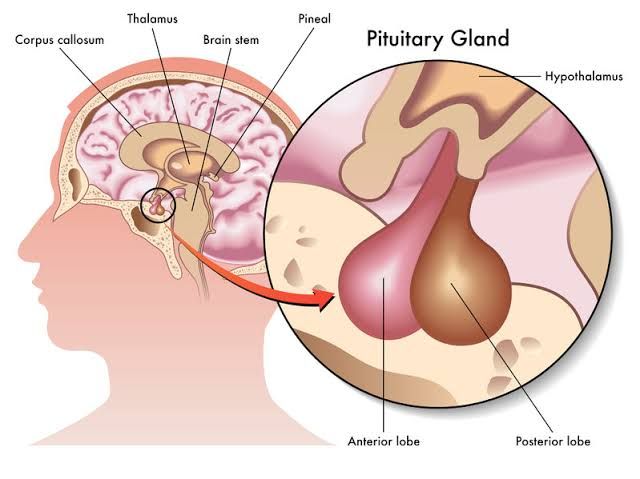
Growth and Metabolic Effects of Growth Hormone
Growth hormone (GH) exerts significant effects on both growth and metabolism. These effects can be categorized as follows:
- Growth Effects:
- GH stimulates the production of insulin-like growth factor-1 (IGF-1), primarily in the liver, which mediates many of its growth-promoting actions.
- IGF-1 promotes linear bone growth by stimulating chondrocyte proliferation and differentiation in the epiphyseal growth plates during childhood and adolescence.
- GH enhances protein synthesis in various tissues, contributing to increased muscle mass and organ size.
- Metabolic Effects:
- GH has anabolic effects on protein metabolism, increasing amino acid uptake and protein synthesis while reducing protein breakdown.
- It has lipolytic effects, promoting the breakdown of triglycerides into free fatty acids (FFA) in adipose tissue, thereby increasing circulating FFA levels.
- GH induces insulin resistance, reducing glucose uptake in peripheral tissues such as skeletal muscle and adipose tissue. This leads to increased hepatic gluconeogenesis and elevated blood glucose levels.
Principal Insulin-Like Growth Factors and Their Relationship to Growth Hormone Actions
The principal insulin-like growth factors are:
- Insulin-Like Growth Factor-1 (IGF-1):
- IGF-1 is the primary mediator of GH’s anabolic effects.
- It is produced mainly by the liver in response to GH stimulation but is also synthesized locally in tissues where it acts in an autocrine or paracrine manner.
- IGF-1 promotes cell proliferation, differentiation, and survival, particularly in bone, cartilage, and muscle.
- Insulin-Like Growth Factor-2 (IGF-2):
- IGF-2 plays a more prominent role during fetal development than postnatal life.
- Its actions are less dependent on GH compared to IGF-1.
Relationship with GH: GH stimulates hepatic production of IGF-1 by binding to growth hormone receptors (GHRs) on hepatocytes. The resulting increase in circulating IGF-1 provides negative feedback to suppress further GH secretion at both the hypothalamic (via somatostatin release) and pituitary levels. Additionally, IGF-binding proteins (e.g., IGFBP-3) regulate the bioavailability of IGFs by prolonging their half-life.
Regulation of Growth Hormone Secretion
GH secretion is tightly regulated by a complex interplay between stimulatory and inhibitory signals from the hypothalamus:
Role of Hypothalamus:
The hypothalamus controls GH secretion through two key hormones:
- Growth Hormone-Releasing Hormone (GHRH):
- GHRH is secreted from the hypothalamus into the hypophyseal portal system.
- It binds to receptors on somatotroph cells in the anterior pituitary gland, stimulating pulsatile secretion of GH.
- Somatostatin:
- Also known as growth hormone-inhibiting hormone (GHIH), somatostatin inhibits GH release from somatotrophs by suppressing cAMP production within these cells.
Feedback Regulation:
Circulating levels of IGF-1 provide negative feedback at both the hypothalamic level (increasing somatostatin release) and pituitary level (directly inhibiting somatotrophs).
Factors Stimulating Growth Hormone Secretion
Several physiological factors stimulate GH secretion:
- Hypoglycemia or fasting states.
- Exercise or physical activity.
- Sleep—particularly during slow-wave sleep stages.
- Stress via catecholamine release.
- High-protein meals or amino acid infusion (e.g., arginine).
- Ghrelin—a gastric peptide that acts synergistically with GHRH to enhance pituitary GH release.
Factors Inhibiting Growth Hormone Secretion
Conversely, certain factors inhibit GH secretion:
- Hyperglycemia or elevated blood glucose levels.
- Elevated free fatty acids in circulation due to lipolysis suppression.
- Aging—GH secretion declines significantly with age.
- Obesity—associated with reduced pulsatility of GH secretion due to high intra-abdominal fat content.
- Exogenous glucocorticoids or chronic stress leading to increased cortisol levels.
Role of Hypothalamus, GHRH, and Somatostatin
The hypothalamus plays a central role in regulating pituitary function through its release of GHRH and somatostatin:
1. Hypothalamus:
The hypothalamus integrates signals from peripheral metabolic cues such as nutrient availability, stress hormones, ghrelin levels, and circadian rhythms.
2. Growth Hormone-Releasing Hormone (GHRH):
GHRH stimulates cyclic AMP production within anterior pituitary somatotrophs via binding to its receptor—a G-protein coupled receptor—thereby enhancing transcriptional activation for GH synthesis and pulsatile release.
3. Somatostatin:
Somatostatin counteracts GHRH action by inhibiting adenylate cyclase activity within somatotrophs through Gi-protein signaling pathways.
Together, these hormones ensure that appropriate amounts of GH are secreted based on physiological needs while preventing excessive or insufficient production.







